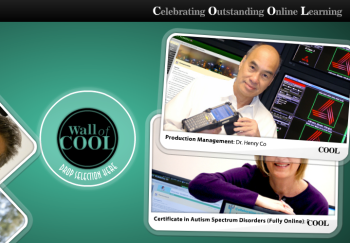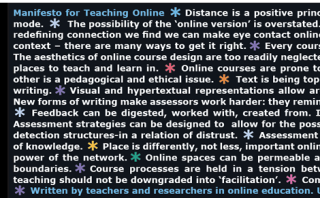 What’s the ‘cool factor’ for Online Learning? As educators, teachers and instructional designers should we even care? The answer is unequivocally yes. But, the problem goes beyond the ‘cool factor’ – online learning has an image problem, a big problem. As educators I think it’s time to figure out what to do about it. How is online learning perceived? In K12 education, higher education and in corporations, I’ve heard these words expressed that capture the impressions collectively – ‘sub-standard’, ‘ineffective’, ‘not social’ or how about this one – ‘boring’. I’m sure you’ve heard all of these and probably more, whether from the students’ perspective, faculty, or potential learner. What we can do about this image problem? How can can we change perceptions and even make online learning seem ‘cool. I have a few ideas:
What’s the ‘cool factor’ for Online Learning? As educators, teachers and instructional designers should we even care? The answer is unequivocally yes. But, the problem goes beyond the ‘cool factor’ – online learning has an image problem, a big problem. As educators I think it’s time to figure out what to do about it. How is online learning perceived? In K12 education, higher education and in corporations, I’ve heard these words expressed that capture the impressions collectively – ‘sub-standard’, ‘ineffective’, ‘not social’ or how about this one – ‘boring’. I’m sure you’ve heard all of these and probably more, whether from the students’ perspective, faculty, or potential learner. What we can do about this image problem? How can can we change perceptions and even make online learning seem ‘cool. I have a few ideas:
Some facts: online learning
Let’s frame the problem. According to Sloan Consortium the growth rate for online enrollment is slowing, even plateauing (I. Elaine Allen and Jeff Seaman, 2011). In fact the growth of online enrolments in degree granting instructions fell from 21% in 2009 to 10.1% in 2011 {this surprised me}. In contrast, there were 845 million active Facebook users at the end of February 2012 [400 million in 2010], and 50 million Twitter users, of which over half log on each day. Granted Facebook and such platforms are not directly related to online learning, but there are significant parallels; the delivery method, the Internet, now accessible 24/7 given the proliferation of mobile devices, and the asynchronous aspect (not in real-time) are the same. Why is online learning with its ability to connect learners with learning 24/7 at a place and time that is convenient for the learner not experiencing the same growth? Hold that thought, we’ll come back to it.
How do college age students perceive online learning
I found this interesting – several research reports showed that though students like the flexibility of online learning, they still aren’t completely convinced online learning is at least as good as face-to-face learning. One paper, Students Perceptions of Distance Learning, Online Learning and the Traditional Classroom (O’Malley), drew this conclusion,
“Our research indicates that students perceive that OL has a significant relative advantage to traditional methodologies. These advantages include saving them time, fitting in better with their schedules, and enabling students to take more courses. They do not believe that they learn more in OL courses and have concerns related to being able to contribute to class discussions. Interestingly, the students seem to be ambiguous when comparing OL to traditional methodologies. They prefer traditional courses to OL courses although they want more OL courses.”
Students aren’t the only ones who are still apprehensive about online learning. Though acceptance is increasing, faculty at higher education institutions are still wary. In 2011, faculty acceptance rates are as follows: 56.5 % have neutral feelings about online instruction, 11.5% disagree with it, and 32.4% agree with online instruction (I. Elaine Allen and Jeff Seaman, 2011). We still have some work to do.
Why the ‘bad image’?
Looking back to early programs of online learning we can determine where the problem began. Early attempts at online instruction for most institutions were simply adaptations of classroom-based courses. Content was uploaded to a learning management platform and professors checked in every once in a while, and hoped for the best. Gradually institutions began to see that this method does not work – pedagogical principles that worked in the classroom do not translate well to the online delivery method – and [fortunately] institutions are realizing that the development and delivery of online education is complex and requires a different and unique skill set.
What we can do?
There are obvious answers including improving the quality of the instructional design process, addressing the uniqueness of the teaching method, and educating instructors in the skills necessary for this ‘new’ environment. Though we need to move beyond the basics, and begin to address the image of online learning and discuss where online learning fits into the educational strategy within our organizations.
Fortunately, there are some great examples of what higher education institutions and K12 are doing in an effort to change the image of online learning. Below are a few [impressive] examples.
 1) The Wall of Cool (Celebrating Outstanding Online Learning) : Created by the Cal Poly Ponoma Faculty – this awesome website is designed to a promote e-learning and showcase successful instructors and best practices. Faculty are featured in brief video clips sharing their successes and strategies. The site is ‘cool’ – and worthy of a visit.
1) The Wall of Cool (Celebrating Outstanding Online Learning) : Created by the Cal Poly Ponoma Faculty – this awesome website is designed to a promote e-learning and showcase successful instructors and best practices. Faculty are featured in brief video clips sharing their successes and strategies. The site is ‘cool’ – and worthy of a visit.
 2) Cool School: Online Content Management site: A Canadian organization, COOL School specializes in the development of web-based resources to be used in learning management platforms like Moodle and Blackboard. I like how this organization puts great effort into making learning resources that are engaging for the student and recognizes the uniqueness of, and embraces the online format.
2) Cool School: Online Content Management site: A Canadian organization, COOL School specializes in the development of web-based resources to be used in learning management platforms like Moodle and Blackboard. I like how this organization puts great effort into making learning resources that are engaging for the student and recognizes the uniqueness of, and embraces the online format.
 3) The Manifesto for Teaching Online
3) The Manifesto for Teaching Online
The idea for writing this post came to me after reading this post about a manifesto for teaching online. Created by students and scholars at the University of Edinburgh the goal (besides as a learning assignment for a student) is to challenge educators to think differently about online education, assessment methods, development, and “In short, we’re trying to contribute to a conversation about what a generative and exciting vision of online education should be.” There has been some criticism, and much discussion since the manifesto hit the web. Worth a quick click to check it out for yourself.
To wrap up, I hope I’ve left you thinking about the image you have of online learning, and perhaps what you might be able to do to challenge and take online learning to the next level. I really like the idea of marketing the image of online learning – even presenting an image of ‘cool’ to the under 25 learner. Seeing what other schools and organizations are doing to differentiate their online learning programs has expanded my views on what can be done to promote online learning, and to present a program in its best light – one that is vibrant, high quality with tremendous potential for a rich learning experience (and maybe even a little bit cool).
Keep Learning 🙂
References
I. Elaine Allen and Jeff Seaman. Going the distance – Online education in the United States, 2011. (2011), Babson Survey Research Group and Quahog Research Group, LLC.

In today’s world anything trending becomes cool. E-Learning is the new trend and has become very popular. It has improvised the traditional way of studying.
LikeLike
Hi Ankur
I agree – anything that is trending is ‘cool’, yet I find some teens rejecting what is considered ‘cool’ by the 30+ crowd, as they view themselves (the teenagers) as the ultimate authority on ‘cool’. Thanks for commenting. Thanks for the link, this platform looks very interesting!
LikeLike
Pingback: 3 Styles of Online Teaching | Doug Woods
Great information. Before you get started it is best to do your research. I have been at it 15 years and there is always something to learn. Technology changes, policies change so having these blogs and mentors can help you successfully teach online.
http://www.drcarolynedwards.wordpress.com
LikeLike
Hi Carolyn. Thanks for your comment! Yes I agree, so much to learn! And like you I find that the resources available are instrumental in keeping current with developments and initiatives in online learning and technology. Thanks again for taking the time to share your experience. 🙂
LikeLike
Pingback: Conexão TE » Blog Archive » Matygo – mudando a sala de aula
Hi Wallace! Thanks for the link! As I read through this – it reminded me that ‘constructivism’ is much aligned with how learners learn online. Perhaps not so much as in a college-credit course or high school level course, but certainly in ‘open’ courses such as MOOC’s, open course ware, as provided by MIT, Stanford, etc where the student is guiding his or her own learning, and sometimes even defining the learning goals. Funny that John Dewey was a big fan of this theory in the 60’s when online learning was unheard of. Thanks for sharing!
LikeLike
I love the post, good work. Maybe I can paint the picture I have in my head for you. Can we think in terms of “technological evolution”? Radio came in the 1920’s, I think? Then television in every home by the 60’s, then computers in every home by the 90’s, then cell phones in every pocket in the WORLD by the 2010. We learned “one on one” for hundreds of years then somebody thought it would be a good idea to put a TV in the classromm for current events. Then they put in a computer. Then they put enough computers in for each child. And every child in the school has a cell phone in their pocket. So…we went from silence in the air to mobile communications, world-wide, 24/7, without limitations, social media that the population of the entire planet is part of, and 9th graders that can write software programs that were unheard of 30 years ago. Enter on-line learning.
I will venture a guess, without research or proof, and say that in 20 years, there won’t be much use of a classroom, at least at the college level and certainly not corporately. I’m sure there will still be classrooms but they will be scarce. My personnal opinion is that alot of managers, instructors, and instructional designers better get on board now while we’re still developing rather than try to catch up when on-line learning becomes the norm rather than an option. It is not going away.
LikeLike
Wow – yes completely true. The rapidity of change is astonishing, and it will be a challenge to keep up. And like you said, it is the managers, instructors etc. that better get on-board now! Not only do these individuals need to keep current and adapt, but it is the organizations and institutions as a whole who need to adapt and embrace change. What will the future of brick and mortar Universities and schools be? I agree with you that the idea of the classroom as we know it will change, or be non-existent, and though I think schools will still be there, they will serve a completely different function than they do now. Perhaps they will be a meeting place for students and teachers on monthly or even quarterly basis? Perhaps to discuss learning after students study online? Perhaps to create new learning? Who knows? But get on the bus or it’s going to leave you behind! Glad you liked the post – thank you for reading and commenting :).
LikeLike
I think this is one of your best post!
LikeLike
Thanks! My biggest supporter!
LikeLike